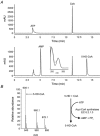K(ATP) channel-independent targets of diazoxide and 5-hydroxydecanoate in the heart
- PMID: 12154175
- PMCID: PMC2290447
- DOI: 10.1113/jphysiol.2002.023960
K(ATP) channel-independent targets of diazoxide and 5-hydroxydecanoate in the heart
Abstract
Diazoxide and 5-hydroxydecanoate (5-HD; C10:0) are reputed to target specifically mitochondrial ATP-sensitive K(+) (K(ATP)) channels. Here we describe K(ATP) channel-independent targets of diazoxide and 5-HD in the heart. Using submitochondrial particles isolated from pig heart, we found that diazoxide (10-100 microM) dose-dependently decreased succinate oxidation without affecting NADH oxidation. Pinacidil, a non-selective K(ATP) channel opener, did not inhibit succinate oxidation. However, it selectively inhibited NADH oxidation. These direct inhibitory effects of diazoxide and pinacidil cannot be explained by activation of mitochondrial K(ATP) channels. Furthermore, application of either diazoxide (100 microM) or pinacidil (100 microM) did not decrease mitochondrial membrane potential, assessed using TMRE (tetramethylrhodamine ethyl ester), in isolated guinea-pig ventricular myocytes. We also tested whether 5-HD, a medium-chain fatty acid derivative which blocks diazoxide-induced cardioprotection, was 'activated' via acyl-CoA synthetase (EC 6.2.1.3), an enzyme present both on the outer mitochondrial membrane and in the matrix. Using analytical HPLC and electrospray ionisation mass spectrometry, we showed that 5-HD-CoA (5-hydroxydecanoyl-CoA) is indeed synthesized from 5-HD and CoA via acyl-CoA synthetase. Thus, 5-HD-CoA may be the active form of 5-HD, serving as substrate for (or inhibiting) acyl-CoA dehydrogenase (beta-oxidation) and/or exerting some other cellular action. In conclusion, we have identified K(ATP) channel-independent targets of 5-HD, diazoxide and pinacidil. Our findings question the assumption that sensitivity to diazoxide and 5-HD implies involvement of mitochondrial K(ATP) channels. We propose that pharmacological preconditioning may be related to partial inhibition of respiratory chain complexes.
Figures




Comment in
-
Cardioprotection by preconditioning: K(ATP) channels, metabolism, or both?J Physiol. 2002 Aug 1;542(Pt 3):666. doi: 10.1113/jphysiol.2002.025601. J Physiol. 2002. PMID: 12154168 Free PMC article. No abstract available.
Similar articles
-
The effects of ischaemic preconditioning, diazoxide and 5-hydroxydecanoate on rat heart mitochondrial volume and respiration.J Physiol. 2002 Dec 15;545(3):961-74. doi: 10.1113/jphysiol.2002.031484. J Physiol. 2002. PMID: 12482899 Free PMC article.
-
Beta-oxidation of 5-hydroxydecanoate, a putative blocker of mitochondrial ATP-sensitive potassium channels.J Physiol. 2003 Mar 1;547(Pt 2):387-93. doi: 10.1113/jphysiol.2002.037044. Epub 2003 Jan 31. J Physiol. 2003. PMID: 12562916 Free PMC article.
-
K+-independent actions of diazoxide question the role of inner membrane KATP channels in mitochondrial cytoprotective signaling.J Biol Chem. 2006 Aug 18;281(33):23733-9. doi: 10.1074/jbc.M602570200. Epub 2006 May 18. J Biol Chem. 2006. PMID: 16709571
-
Mitochondrial ATP-dependent potassium channels. Viable candidate effectors of ischemic preconditioning.Ann N Y Acad Sci. 1999 Jun 30;874:27-37. doi: 10.1111/j.1749-6632.1999.tb09222.x. Ann N Y Acad Sci. 1999. PMID: 10415518 Review.
-
The mitochondrial K(ATP) channel and cardioprotection.Ann Thorac Surg. 2003 Feb;75(2):S667-73. doi: 10.1016/s0003-4975(02)04689-1. Ann Thorac Surg. 2003. PMID: 12607710 Review.
Cited by
-
KATP channels and cardiovascular disease: suddenly a syndrome.Circ Res. 2013 Mar 29;112(7):1059-72. doi: 10.1161/CIRCRESAHA.112.300514. Circ Res. 2013. PMID: 23538276 Free PMC article. Review.
-
Factors mediating remote preconditioning of trauma in the rat heart: central role of the cytochrome p450 epoxygenase pathway in mediating infarct size reduction.J Cardiovasc Pharmacol Ther. 2013 Jan;18(1):38-45. doi: 10.1177/1074248412437586. Epub 2012 Mar 9. J Cardiovasc Pharmacol Ther. 2013. PMID: 22407888 Free PMC article.
-
Effects of Pinacidil and Calcium on Succinate-Energized Rat Heart Mitochondria in the Presence of Rotenone.Dokl Biochem Biophys. 2019 Jul;487(1):277-281. doi: 10.1134/S1607672919040070. Epub 2019 Sep 26. Dokl Biochem Biophys. 2019. PMID: 31559597
-
The effects of ischaemic preconditioning, diazoxide and 5-hydroxydecanoate on rat heart mitochondrial volume and respiration.J Physiol. 2002 Dec 15;545(3):961-74. doi: 10.1113/jphysiol.2002.031484. J Physiol. 2002. PMID: 12482899 Free PMC article.
-
Matrix volume measurements challenge the existence of diazoxide/glibencamide-sensitive KATP channels in rat mitochondria.J Physiol. 2003 Mar 15;547(Pt 3):893-902. doi: 10.1113/jphysiol.2002.035006. Epub 2003 Jan 31. J Physiol. 2003. PMID: 12562892 Free PMC article.
References
-
- Baines CP, Goto M, Downey JM. Oxygen radicals released during ischemic preconditioning contribute to cardioprotection in the rabbit myocardium. Journal of Molecular and Cellular Cardiology. 1997;29:207–216. - PubMed
-
- Becker LB, Vanden Hoek TL, Shao ZH, Li CQ, Schumacker PT. Generation of superoxide in cardiomyocytes during ischemia before reperfusion. American Journal of Physiology. 1999;277:H2240–2246. - PubMed
-
- Berman MC, Kewley CF, Kench JE. Contribution of inhibition of NADH-dehydrogenase to the cardiotoxic effects of halothane. Journal of Molecular and Cellular Cardiology. 1974;6:39–47. - PubMed
-
- Cohen MV, Baines CP, Downey JM. Ischemic preconditioning: from adenosine receptor to KATP channel. Annual Reviews in Physiology. 2000;62:79–109. - PubMed
-
- Forbes RA, Steenbergen C, Murphy E. Diazoxide-induced cardioprotection requires signaling through redox-sensitive mechanisms. Circulation Research. 2001;88:802–809. - PubMed
Publication types
MeSH terms
Substances
LinkOut - more resources
Full Text Sources
Other Literature Sources
Research Materials

